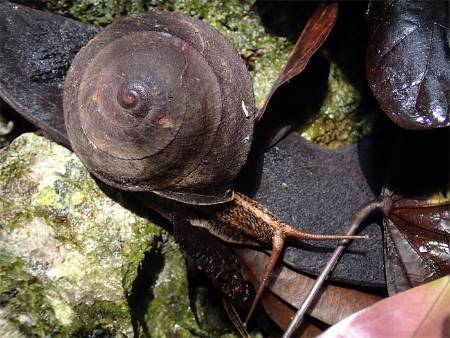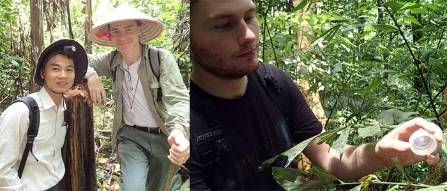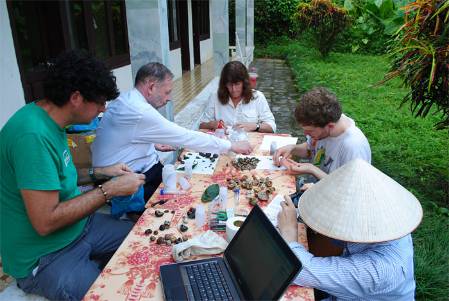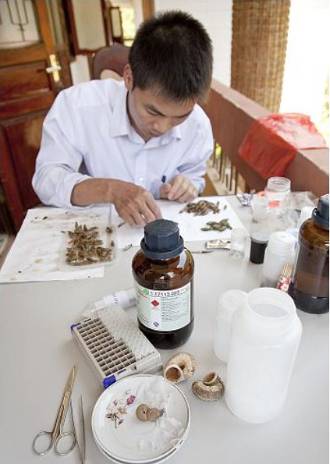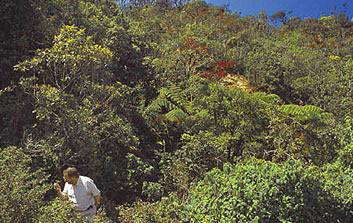Before I tell you about our time in the lab, I thought I would share with you another video taken by Paul Pearce Kelly in Cuc-Phuong. The video below is of a predatory slug species from the genus Atopos. These slugs either eat small microsnails whole or bore through larger snails' shells using their toothed, tongue-like radula.
After our exciting and productive time in Cuc Phuong National Park we headed back to Hanoi to process the material for frozen tissue collections. Our expedition has been jointly funded by the Natural History Museum and the Frozen Ark, and one of our aims is to collect frozen tissue material and viable cells.
The Frozen Ark was set up in 1996 and is run by a consortium of 22 universities, museums, zoos and aquaria from 8 different countries, with the aim to conserve frozen cells containing DNA from endangered animals before they go extinct. Since many limestone habitats are under threat from the construction industry (the limestone is used in the manufacture of cement and other building materials), we decided that terrestrial molluscs would be a great addition to the Frozen Ark collections.
Chris preparing tissue whilst Jackie puts the samples on ice.
The specimens used for these processess have been brought back from Cuc-Phuong live, to be processed in the laboratory. For the frozen tissue samples, small slices of the foot of the snail (the part it moves on) are placed in sterile tubes and frozen at -80 degrees Celsius. These samples will hopefully yield high quality DNA. Five multiple sets are stored for our current research, long term Museum storage, the Frozen Ark in London, the Frozen Ark in Nottingham and for the Frozen Ark in Vietnam.
The viable cell preparations are also taken from tissue samples but they are mashed up in an antibiotic solution (to prevent damage by bacteria etc.), and then mixed with a buffer chemical so that as the tissues are frozen, again at -80 degres Celcius, the cells will not fracture and will remain whole. It is hoped that future technology will allow us to use these cells and the genetic content within to re-create and re-introduce extinct species.
(L-R) Jackie, Chris and Fred hard at work on the cold-chain-gang (sorry terrible molecular joke).
The two experts in our group helping us with these processes are Jackie Mackenzie-Dodds and Dr. Chris Wade, who are both on the advisory board of the Frozen Ark. Jackie is the collections manager of the molecular and frozen tissue collections at the Museum, and Chris is a lecturer of genetics and a molecular biologist at Nottingham University. I'm glad they are both here as the frozen tissue preparations are complex and intricate and I have never done anything like this before.
We have spent the last few days collecting in Huu Lien Nature Reserve and tomorrow will be our last day collecting in the field so in my next blog I'll be telling you all about the strange and wonderful things we have found, and a little about our last few days in Hanoi.
Fruit for Thought
As well as the delicious savoury dishes we have been sampling a wealth of unusual (at least to me) fruit. My favourite has to be the Rambutan, a egg-sized red fruit covered in green hairs. I'm afraid I don't have any pictures because I ate them all before I thought to take a photo so you'll have to Google them. They taste a bit like a grape but are sweeter and juicier - delicious.
Persimmon (the red fruit) and Guava's (the green ones) with a little lotus tea - what a lovely afternoon treat.
We've also been eating ...
Pomelo - a sharp citrus fruit with a grapefruit-like taste
Guava - like a tropical quince
Persimmon - a bit like across bewteen a plum and a tomato, much nicer than it sounds
Longans - like large lychees but sweeter
Forest Bananas - shorter but wider than our usual bananas, tastes earthier and banana-ery if that makes any sense
Jicama - a tuber that tastes like apple and is often served with savoury courses
Bite Me
0 Leech bites ... all though I have a funny feeling this may change tomorrow as it is due to be a stormy evening
12 mosquito bites
Ant bites, fading and almost gone



